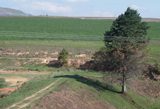Weaver species
Choose different species from drop-down list and press 'Go' button. See Full species list.Southern Masked Weaver Ploceus velatus
IUCN: Least concern Discovery: 029Categories: acacias, fruit, waterbirds, gum, Gymnogene, nectar, pest, Nest use, palm, double nests,
News items about species
Discovery
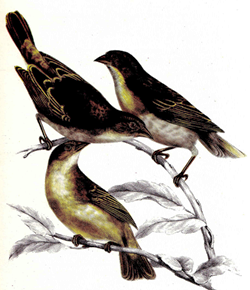
figure from Smith 1845 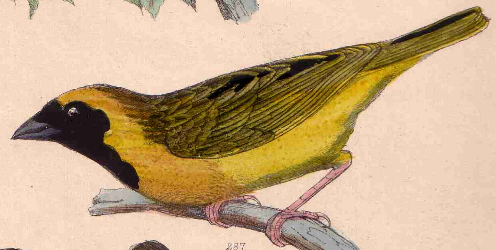
figure from Reichenbach 1863 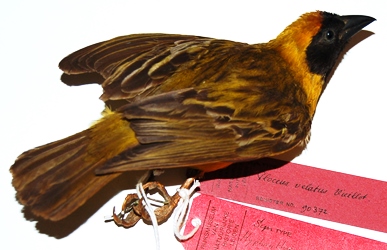
type specimen in Leiden 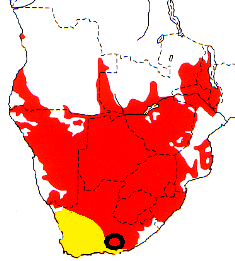
distribution, type locality circled; yellow shows modern range expansion IntroductionThe Southern Masked Weaver was formally described by Louis Jean Pierre Vieillot, a French ornithologist. The Southern Masked Weaver was first collected by Francois Le Vaillant, who travelled in South Africa in 1781-84. When Le Vaillant returned to Europe, most of his specimens where sold or given to Coenraad Jacob Temminck, who had sponsored Le Vaillant's travels. Temminck produced a catalogue of these birds in 1807 and briefly described the Southern Masked Weaver, without providing a scientific name, but calling it "Le troupial a masque-noir" (The oriole with a black mask). He noted that it came from "Namaquois" (Namaqualand). However, several specimens that Le Vaillant listed as from Namaqualand are actually from the Karoo, and Brooke (1985) restricted the type locality of the Southern Masked Weaver to Graaff-Reinet - earlier authors had restricted the type locality to other sites that were found to be incorrect. Le Vaillant reached the Eastern Cape in 1782, and passed through the Karoo in early 1783 on his return to Cape Town.Vieillot based many of his descriptions on the work of Temminck 1807, but included a scientific name. The Southern Masked Weaver was first illustrated in 1828 in Andrew Smith's description of the species. Smith illustrated only non-breeding birds, and the first male in breeding plumage to be painted was by Reichenbach (1863). Scientific citationPloceus velatus Vieillot 1819 Nouv. Dict. Hist. Nat., nouv. ed., 34:132 Namaqualand, restricted to Graaff-Reinet, E Cape, by Brooke, 1985, Ostrich 56, 214-215.Meaning of namesvelatus Latin: veiled, covered (velare, to cover) [referring to the mask of the breeding male].First English nameMasked weaver bird (Smith 1828).Alternate namesAfrican Masked Weaver, Black-fronted Weaver, Capricorn Weaver-bird, Greater Masked Weaver, Half-masked Weaver, Lichtenstein's Weaver bird, Mariqua Weaver bird, Masked Weaver, Namaqua Masked Weaver, Shelley's Weaver Bird, Yellow Masked Weaver, Zambesi Masked Weaver.CollectorLe Vaillant.Date collectedFeb-March 1783, when Le Vaillant was in the Karoo.Locality collectedNamaqualand, restricted to Graaff-Reinet.Type specimensTwo type specimens are in the Leiden Museum (RMNH_90372 and RMNH_90373). |
The above is based on Weaver Wednesday 2, a weekly series about the discovery of each weaver species.
This species text first appeared as
Weaver Wednesday [146] - Discovery [29]: Southern Masked Weaver on 2015-04-01
1. Basic biology
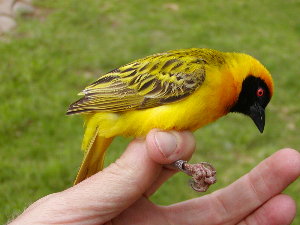
adult male in breeding pluamge 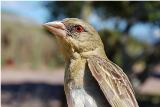
adult female Identification. The Southern Masked Weaver male in breeding plumage (photo above left) is bright yellow with a black mask and red eye. In non-breeding plumage it resembles the dull-coloured female, but retains a reddish eye. The female usually has a brown eye but about 29% of breeding females have a reddish eye (photo above right, see pdf paper on weaver eye colours). Distribution. The Southern Masked Weaver has no subspecies listed in the Handbook of the Birds of the World, Vol. 15. Several subspecies have been proposed in the past, but this species is likely to show penotypic variation, ie. the size and plumage variation is due to environmental factors rather than geographic variation in genotypes. It is found in the southern third of Africa as far north as Angola, Zambia, Malawi and Mozambique.
It did not occur in the Western Cape historically (see map here). Originally its distribution ranged from the lower Orange River across to Port Elizabeth. It then expanded its range into the Western Cape and then Northern Cape as shown in the map. It is still sparse in the arid region south of the lower Orange River. Habitat. It is found in a wide variety of habitats, including gardens, but is usually less common in coastal regions. This species is gregarious when not breeding, often roosting and feeding in large numbers. Food. It is mainly a seed-eater, although also feeds on arthropods, nectar, and other items. Breeding.
The Southern Masked Weaver is polygnous. The male builds a neat nest which contains a ceiling inside the main structure as rain-protection. If a female accepts a nest, she lines the chamber with grass seed heads or feathers. Nests are built in trees, bushes, reeds, bamboos or man-made structures, like barbed wire fences. The latter is well illustrated by the very first PHOWN record (Photo below, phown 1). One of the most abnormal weaver nests was built by this species - see phown 694.
Colonies in drier areas tend to be larger with several males present, while this weaver tends to disperse into single-male colonies in urban areas with around 3-10 nests per male. Eggs vary in colour, bluish or whitish, being plain or marked with fine or larger spots and blotches. This is one of the most common host species to the Diederik Cuckoo. Chicks are fed by the female, and very rarely by the male. When fledged, the juveniles may remain in the same area or disperse several kilometers. |
The above is based on Weaver Wednesday, a weekly series about weaver species.
This species text first appeared as
Weaver Wednesday [10]: Southern Masked Weaver on 2012-08-22
2. Breeding facts
| Pair bond Polygynous, with two or three females present in the territory simultaneously and up to twelve females acquired by one male during a season Breeding season Dec-Jan (sometimes to Mar) on Sao Tome; Nov-Apr in Angola, Oct-Mar in Zambia, Jan-Apr in Malawi, Nov-Feb in Mozambique, Aug-Mar in Zimbabwe, Sept-Mar (peak in Nov) in Botswana; in South Africa, Aug-Oct in Western Cape (winter-rainfall region) and Jul-Mar elsewhere; within a region timing can vary locally depending on rainfall Nest site often placed at tips of branches over dry land, seldom in reeds, sometimes in tree over water Nest building woven by male, lined by female Colony size one male apparently built 52 nests during single breeding season Clutch size 2-4 eggs (mean 2.5 in South Africa) Egg colour white, pink, pale green or blue, either plain or speckled, spotted and blotched with grey, brown, red or purple Egg size average size of 389 eggs 20.9 x 14.5 mm (South Africa) Incubation incubation by female, period c. 14 days Chicks and nestling period chicks usually fed by female only, nestling period average 16 days; male feeds nestlings or fledglings only rarely but sometimes feeds second brood |
Breeding information based on Handbook of the Birds of the World, Vol. 15.
3. Photos of Weaver Nests
 Vm 31093 |  Vm 31090 |  Vm 31089 |  Vm 31088 |  Vm 31054 |  Vm 31047 |
Thumb-nails of most recent PHOWN records - click on one to see its full record
See all PHOWN records for this species here.
PHOWN (Photos of Weaver Nests) provides valuable info on breeding distribution and colony sizes of weavers.
You can contribute by registering and submitting photos at Virtual Museum webpage.
4. Breeding distribution
Google map showing distribution (For species with small ranges you need to zoom in at the correct area to see the range):
yellow blob - range of weaver species; read more about this here.
![]() - PHOWN records with photos
- PHOWN records with photos
![]() - PHOWN records with no photos (Nest Record Cards, other records)
- PHOWN records with no photos (Nest Record Cards, other records)
![]() - Birdpix records
- Birdpix records
![]() - comments on out of range records, or interesting records
- comments on out of range records, or interesting records
![]() - type locality
- type locality
CLICK on the marker on the map to see individual record details.
5. Range changes
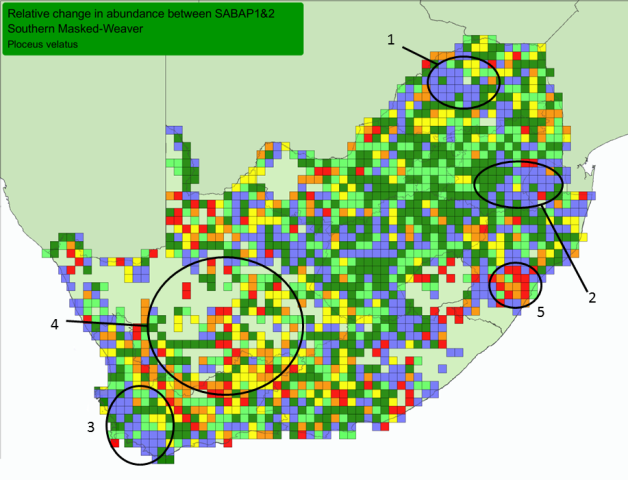
Red, orange and yellow = cells with very large, large, and small relative decreases Blue, dark green and light green = cells with very large, large and small relative increases. Cells = quarter-degree grid cells; Only cells with at least 4 checklists in both SABAP1&2 shown. All cells had this species recorded in SABAP1 or in SABAP2 or in both (more about interpretation at Biodiversity Observations 7.62: 1-13).
Range changes in SA
The points below match the points on the map above. Areas with very large increases include:
Mixed results (increases and decreases):
Areas with very large decreases:
Range changes elsewhereZimbabwe: increase in Harare due to vegetation and gardens (Brooke 1963a). | |||||||||||||||||||||||||||||||||||
The above is based on Weaver Wednesday 3, a weekly series about range changes in South African weaver species.
This species text first appeared as
Weaver Wednesday 3 [251] - Range changes [14]: Southern Masked Weaver on 2017-04-05








